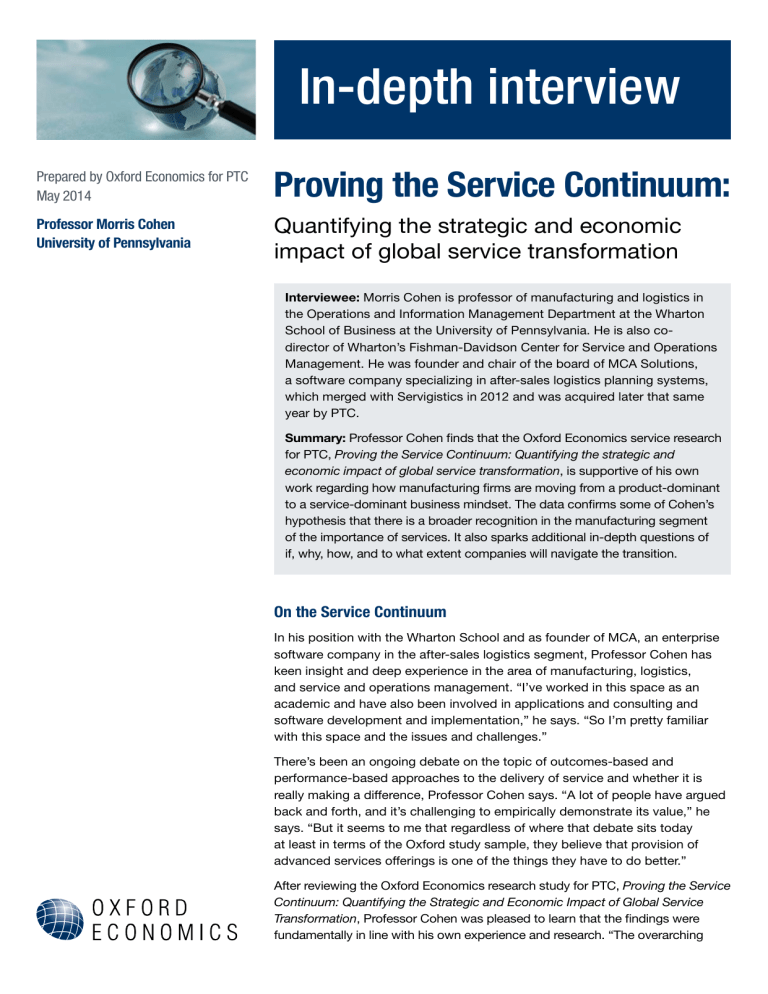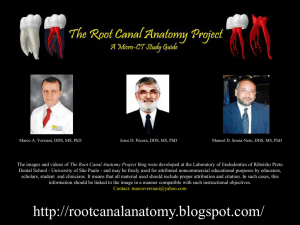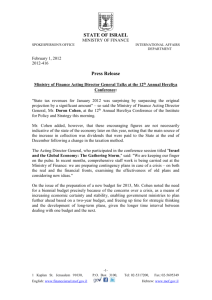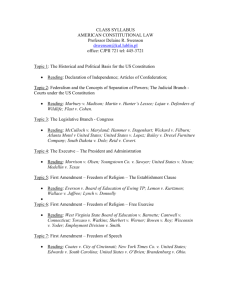Proving the Service Continuum

I n-depth i nterview
Prepared by Oxford Economics for PTC
May 2014
Professor Morris Cohen
University of Pennsylvania
Proving the Service Continuum:
Quantifying the strategic and economic impact of global service transformation
Interviewee: Morris Cohen is professor of manufacturing and logistics in the Operations and Information Management Department at the Wharton
School of Business at the University of Pennsylvania. He is also codirector of Wharton’s Fishman-Davidson Center for Service and Operations
Management. He was founder and chair of the board of MCA Solutions, a software company specializing in after-sales logistics planning systems, which merged with Servigistics in 2012 and was acquired later that same year by PTC.
Summary: Professor Cohen finds that the Oxford Economic s service research for PTC, Proving the Service Continuum: Quantifying the strategic and economic impact of global service transformation , is supportive of his own work regarding how manufacturing firms are moving from a product-dominant to a service-dominant business mindset. The data confirms some of Cohen’s hypothesis that there is a broader recognition in the manufacturing segment of the importance of services. It also sparks additional in-depth questions of if, why, how, and to what extent companies will navigate the transition.
On the Service Continuum
In his position with the Wharton School and as founder of MCA, an enterprise software company in the after-sales logistics segment, Professor Cohen has keen insight and deep experience in the area of manufacturing, logistics, and service and operations management. “I’ve worked in this space as an academic and have also been involved in applications and consulting and software development and implementation , ” he says. “So I’m pretty familiar with this space and the issues and challenges.”
There’s been an ongoing debate on the topic of outcomes-based and performance-based approaches to the delivery of service and whether it is really making a difference, Professor Cohen says. “A lot of people have argued back and forth, and it’s challenging to empirically demonstrate its value,” he says. “But it seems to me that regardless of where that debate sits today at least in terms of the Oxford study sample, they believe that provision of advanced services offerings is one of the things they have to do better.”
After reviewing the Oxford Economics research study for PTC, Proving the Service
Continuum: Quantifying the Strategic and Economic Impact of Global Service
Transformation , Professor Cohen was pleased to learn that the findings were fundamentally in line with his own experience and research. “The overarching
“We are moving to an environment where a) service is now universally recognized as being more important than it has been; and b) in order to reap the benefits of that you have to expand to more of an outcomesbased sort of situation.”
Professor Morris Cohen
University of Pennsylvania finding that you have is that there is increased emphasis on the importance of service,” he says. Survey respondents clearly understand the fundamental value of service, and the significance of integrating and delivering that service. “They all seem to—or most of them seem to—expect to be doing a lot better, they expect service to be of increased importance and they see a high correlation between that and a positive revenue impact,” Professor Cohen explains.
“I think that it is a very important finding—to see that in the next three years these manufacturers fully expect to be engaged in the provision of outcomes-based relationships with their customers, often times associated with performance-based contracting. And that is consistent with a lot of things that have been happening at least in the last five to 10 years [inside the manufacturing industry]” says Professor Cohen. “I think that’s a very important finding, that we are moving to an environment where a) service is now universally recognized as being more important than it has been; and b) in order to reap the benefits of that you have to expand to more of an outcomesbased sort of situation.”
PTC’s Service Continuum—Today and In Three Years
95%
Today In 3 years
15%
Lagging
0%
23%
Formative
1%
31%
Moderate
1%
18%
3%
Progressive
13%
Best in class
The findings show that firms will emphatically expand their business models toward outcomes-based relationships with their clients, often adopting performance-based contracts and other similar advanced services. Professor
Cohen wonders how this shift toward servitization will take place and what incentives will allow this to happen.
In his experience, many service providers prefer the old “break/fix” service system, or resist embracing more of an outcomes-based approach to service even though their customers are demanding this change. “Service providers, if they had their druthers, would love to stay in kind of a cost-plus or time-andmaterial type of mode where they get paid a very high margin for delivering service. But it’s not what their customers are demanding. There’s also a lot of a risk, and customers are looking to push the risk for service back to their suppliers.” The transition to a performance-based model is being pushed “by customers. It’s a move that is being driven by the market,” says Professor Cohen.
Professor Cohen adds that “a lot of research and applied work in this area has focused on this notion of incentive alignment—that by moving to an outcomesbased model, what we are doing is effectively aligning incentives” to see
customers and service providers working together for the same outcome. “So incentive alignment should lead to a win/win situation, where all parties are better off in terms of cost, in terms of system performance. It seems that this message has been accepted by the majority of the respondents.”
Challenges along the Service
C
ontinuum
Professor Cohen is intrigued to learn more about how companies shift from one stage of the Service C ontinuum to more advanced services models. “It’s not like a sw i tch i s thrown and everybody is now shifting to an outcomes-based business model. I think it’s an evolution and there are a lot of challenges in getting there.”
The research confirms Professor Cohen’s presumption that when it comes to shifting to an outcomes-based business model, challenges abound.
Referring to the Oxford Economics research survey for PTC, Professor Cohen notes that “if you’re a more sophisticated company, the things that you are going to focus on are very different than a company that is at a more basic level.”
Obstacles along the Service Continuum
% of respondents
60%
50%
40%
30%
20%
10%
Lagging Formative Moderate Progressive
Limited synergy between service with sales and marketing
Too many logistical issues to create larger strategy
Lack of specialized technology for service
Not enough of the right resources to take service in-house
Lack of centralized processes
Company culture is still product-centric
Talent acquisition, retention
Best in class
He goes on to say that the survey respondents “all agreed on the goals, and they all expect that it’s going to be better, and you have some information about why they think it’s difficult or what they need to do differently. My read on that is that it has to do with making better decisions, doing more effective planning, making more effective use of your resources, reorganizing both internally and externally, and aligning incentives.”
Professor Cohen noted that the number one issue for companies at the early stages of adopting the Service Continuum is the lack of specialized technology for service. “I think specialized technology tools for service is a message that we would all emphasize—you have to have tools that have been designed, built, and delivered for service,” he says. “If you don’t have that or recognize that, then you’re going to be at the bottom of the spectrum.”
A core challenge that remains is overcoming a company culture that tends to remain product-centric. Professor Cohen believes there could be several reasons f o r this obstacle. One reason, he hypothesizes, is that integrating services in a product culture is challenging in the initial stages of the Service
C ontinuum. Respondents confirm that a company culture being productcentric is an obstacle that “goes up for the first three stages of the Service
C ontinuum as you become more sophisticated and you become more aware that this [service] is important. And then as you go to the far right [on the Service
C ontinuum], they’ve actually acted on it and maybe feel they actually have done something to alleviate it.” Another plausible explanation is that the firm has hit a tipping point in moving from a product-dominant to a service-dominant mentality.
Professor Cohen also believes that “some products and some technologies lend themselves to be more product-centric.” For some companies, “it’s all about the technology, or it’s all about the product which defines them,” while others “are much more service oriented by the nature of what they do, or the nature of their technology.”
As companies shift to the right on the Service C ontinuum toward more advanced services offerings, the problems they face tend to be less about tools for service delivery and more about their organization. The number one issue at the outcomes-based end of the Service Continuum is the limited synergy between service and sales and marketing. Those companies “that have already bought into that [the idea of advanced services] are facing perhaps a more sophisticated challenge at the next stage, which is really looking for synergies across functional areas, which is more an issue of organizational incentives rather than basic tools,” Professor Cohen adds.
Professor Cohen also notes that as companies move to the right along the Service Continuum they show a proclivity toward centralizing their management of service offerings. “After all, you might think that greater individual customization might offer better service,” says Professor Cohen.
“One of the lessons that I’ve learned over the years is that the whole service lifecycle management, the delivery of service bundled with products, is something that can be highly differentiated where one size does not fit all.
You have to really understand the differences of the customer and provide a variety of things that the customers want. That’s where the potential for getting strategic advantage lies.”
He also suggests that perhaps existing service offerings in dispersed service centers aren’t sophisticated enough, and that greater centralization may encourage companies to develop a more sophisticated approach. “Perhaps the answer to this puzzle,” Professor Cohen suggests, “is that companies expect to reorganize the way they’re managing this function to be more centralized, to use more sophisticated tools, in a more holistic approach. Services have often been left to people who have been running service operations in fairly rudimentary ways over the years, and have resisted change.” So maybe the centralization approach is a positive development , says Professor Cohen.
“These are all great findings consistent with the mantra that we [at Wharton’s
Fishman-Davidson Center for Service and Operations Management] have been preaching for many years. It is nice to see the kind of corroboration of the fact that companies have bought into this [concept of servitization] and fully expect to improve their position and increase the importance of service.”





